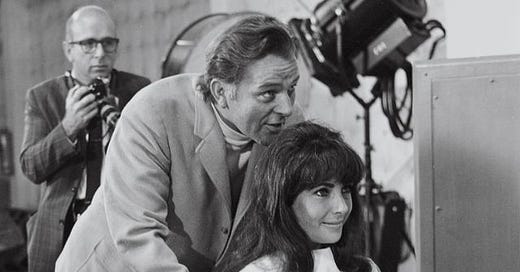A Look Back: March Book Review [2024]
Rebranding as a Richard Burton and Elizabeth Taylor stan
In March, I read a Gwendoline Riley novel and a Claire Keegan short story collection, plus made constantly spewing fun facts about Who’s Afraid of Virginia Woolf? (1966) an integral part of my personality.
Let’s get into it:
My Phantoms by Gwendoline Riley (2021) — I first came across British author Gwendoline Riley’s writing in fall of 2022, when I read her sixth novel, First Love (2017). My Phantoms (2021), issued alongside its predecessor by New York Review Books, stems from a similar recipe. Like Sally Rooney, Riley mixes an analogous set of ingredients across her work; a 40-something Liverpool girlie-turned-Londoner, a covertly narcissistic mother, and an overtly narcissistic father propel the plot in First Love and My Phantoms alike, underscoring the unending umbilical cord of family trauma.
James Wood, author of How Fiction Works (2008), reviewed both books side by side in The New Yorker last year. He writes: “I don’t recall reading many novels as grotesquely honest about the original sin of being born to inadequate parents…Both of her [Riley’s] novels have the unguarded nudity of correspondence; they have no time for the diplomatic niceties, the aesthetic throat-clearing of most literary fiction. The two novels relate to each other like twitching limbs from the same violated torso. Each one is narrated by a young, bookish woman — Neve in First Love, Bridget in My Phantoms — who lives in London with a male partner. In each book, this young woman, reared in lower-middle-class Liverpool, is struggling to achieve independence from her ghastly and abusive parents, who separated when she was small. In each book, the narrator’s father is a cruel boor and her mother a damaged fool, wreathed in the spoils of her defeat. In each book, the awful father is dispatched within the first forty or so pages, with the novel spending the balance of its negative ledger on the awful mother…mothers are the life problems with which Neve and Bridget must do serious battle.”
My Phantoms takes the form of a reflection, a kind of confessional. Told in first person and colored by Riley’s characteristically incisive prose, Bridget, an academic in her forties, looks back on her childhood and meditates on her troubled relationship with her parents. The first third of the narrative centers primarily on her father’s brand of barbarism before, as Wood notes, the latter two thirds shift toward the more nuanced dynamic between Bridget and her mother, Helen.
I typically have limited patience for novels that narrate the past, but Riley occupies it, resurrects it, with such immediacy through the biting detail of Bridget’s memory. For instance, Bridget recalls: “If I ever took a book with me on Saturday, I had to bank on my father snatching it from me at some point…If the writer or the book was one he had heard of he often used to just say ‘Huh!’ Almost involuntarily. As if something was repeating on him. Sometimes, too, it was his grim duty to inform me — as one who should really have done her due diligence — that the writer in question had been seen on television by him, by Lee Grant, and deemed a ‘creep’ or a ‘poser.’ All I had to do was ask. But there it was. On those occasions he would give the book back to me with a pitying frown, it being a meaningless, hollowed-out object now.”
Through a combination of dialogue and narration, Riley captures the subtle preoccupations that comprise the primer of her characters’ colors. For instance, Helen remains fixated on not having met Bridget’s boyfriend, concerned about what an imaginary peanut gallery of people might think. Bridget narrates: “‘Everyone meets their children’s boyfriends,’ she [Helen] was saying now, urgently, insistently, her little steps trying to keep up with my longer stride. I was walking with the tight-lipped and blinkered intent of someone leaving a crime scene. ‘It’s so embarrassing,’ my mother said, ‘when people ask.’…She made her one point repeatingly. Made it with the toneless insistence of a locked-out cat. People asked.” Here, Riley captures the specific flavor of looping fixation that comes to form Helen’s every thought, every word. Then, she punctures it with the astute veracity of Bridget’s observations. This pattern repeats throughout the narrative, coalescing to create what The Guardian aptly calls a “devastating, quietly brutal novel.”
So Late in the Day: Stories of Women and Men by Claire Keegan (2024) — This new collection from Claire Keegan, whose novel, Small Things Like These (2020), I discussed in the December newsletter, consists of three short stories: “So Late in the Day,” “The Long and Painful Death,” and “Antarctica.”
As Kirkus Reviews describes: “These stories, which span Keegan’s career, have been collected and repackaged in the wake of her Booker Prize–shortlisted novel, Small Things Like These, and the American publication of her novella, Foster. The final story, “Antarctica,” in which a married woman seeks out sex while away from her family, was originally published in 1999, while the title story first appeared only last year. The stories have been carefully selected, however, to be read together; all three powerfully probe the problem of gender relations in modern Ireland and England…Keegan precisely observes the subtle dynamics between men and women, be they strangers or romantic partners, and how those dynamics can shift and curdle with little warning.” As always, her clean, clipped prose cuts to the core of the emotional tension bubbling beneath each narrative.
“So Late in the Day” operates as a meditation on heartbreak, relives a relationship past its prime to retrace what went wrong (“‘I didn’t think it would be like this, is all,’ he said. ‘I just thought about you being here and having dinner, waking up with you. Maybe it’s just too much reality.’”). It teases out the subjectivity of reality, the subtlety of financial strain, and, ultimately, the harm in keeping score. To get a taste of the full collection, you can read this particular story, the most recent, as a standalone in The New Yorker here.
Meanwhile, “The Long and Painful Death” deals with a tug of war between an in-residence Irish writer and a German professor (“She resented for a moment, the fact that there was a number. What had begun as a fine day was still a fine day, but had changed; now that she had a fixed time, the day in some way was obliged to proceed in the direction of the German’s visit”), and “Antarctica” follows a “happily married woman” in pursuit of an extramarital one-night stand (“Every time the happily married woman went away, she wondered how it would feel to sleep with another man. That weekend she was determined to find out. It was December; she felt a curtain closing on another year. She wanted to do this before she got too old.”). In these two stories, men appear as wolves in sheep’s clothing, as the socially stunted professor and “the least threatening man she’d ever known,” before irritating and sinister truths ooze to the surface.
Cocktails with George and Martha: Movies, Marriage, and the Making of Who’s Afraid of Virginia Woolf? by Philip Gefter (2024) — Run, don’t walk!! This book has everything! Mike Nichols perfecting the art of practicing “social jiu jitsu” on unsuspecting souls (aka: cementing himself as the most Scorpio Scorpio who has ever Scorpioed), Elizabeth Taylor subtly demanding thousands of dollars in diamonds (as she should), and Richard Burton stressing about his acne scars (so valid, king). Cocktails with George and Martha, like Ninety-Nine Glimpses of Princess Margaret (2017), which I discussed in the November newsletter, reads “like a top-tier grocery store aisle issue of People.”
The narrative teases out how Who’s Afraid of Virginia Woof? — first as a play, then as a film — became a lightning rod in the mid-sixties cultural zeitgeist. For those of you unfamiliar with both versions, per film director Mike Nichols, the story “is about a couple [George and Martha] who comes home late after a party. She has invited another couple [Nick and Honey] over for a nightcap. They drink and they argue and then the guests go home.” Over the course of an extended nightcap from hell, George, Martha, and their younger counterparts toe the line between truth and illusion, cracking open the cores of their respective relationships. Per Cocktails with George and Martha author Philip Gefter: “While unique as characters, George and Martha are representative of any married couple in that they are always aware of the private subtext playing out below the public face of their relationship.”
Gefter traces playwright Edward Albee’s development of the script in 1950s Greenwich Village to the play’s Tony-winning — and Pulitzer-snubbed — Broadway run. The bulk of the book then shifts to focus on the 1966 film, from casting to production to release. Gefter reanimates the environment of the set, a cocktail of strong personalities — including a pre-The Graduate (1967) Mike Nichols as director, Brooks Brothers-sporting square Ernest Lehman as producer, and the couple of the decade, Richard Burton and Elizabeth Taylor, as George and Martha — fixated on their respective versions of success.
Okay, see you at the end of the month!
xo,
Najet






